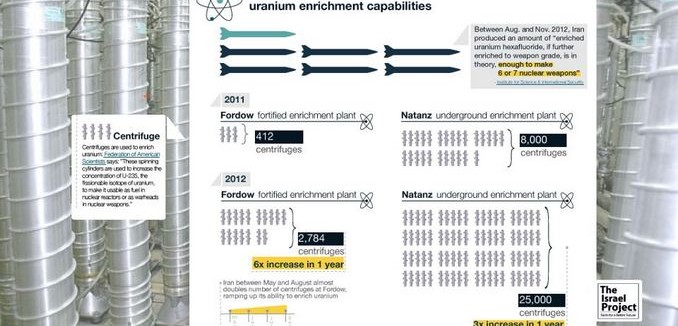With less than a week to go before Iran meets with the P5+1 to discuss its atomic program, Tehran has begun to install advanced IR-2m centrifuges at its Natanz enrichment facility (U.S. officials are describing the move as “provocative”). The installation will allow Iran to enrich uranium up to five times above the previous configuration. When Iran announced its intention to install the new centrifuges, some Western analysts suggested that the regime was blustering. That skepticism appears to have been misplaced:
Iran already announced last week that it had begun mounting the new enriching centrifuges, but one diplomat said at the time that the announcement was premature with only a “small number” on site and not yet installed. Diplomats told The Associated Press on Wednesday, however, that installation was now well on its way, with inspectors from the International Atomic Energy Agency seeing close to 100 or more machines mounted when they toured the site a few days ago. Depending on experts’ estimates, the new-generation centrifuges can enrich uranium three to five times faster than Iran’s present working model.
Meanwhile the U.N.’s nuclear watchdog released its latest assessment [PDF] of the Iranian nuclear program. In addition to confirming the installation of the IR-2m centrifuges at Natanz, it indicated that the overall number of installed centrifuges has increased substantially and that installation is proceeding occurring faster than expected. A 2012 IAEA assessment [PDF] had put the number of installed centrifuges at the facility at 25,000, which was itself an increase over the 2011 estimate of 8000 [PDF]. The report also indicates – as early leaks indicated – that Iran has ramped up work at its underground military facility at Fordow.
The IAEA’s 2011 report had already reported that the agency was “becoming increasingly concerned about the possible existence in Iran of undisclosed nuclear-related activities involving military-related organizations, including activities related to the development of a nuclear payload for a missile, about which the Agency has regularly received new information.” That report linked Iran to “activities that are relevant to the development of a nuclear explosive device.”
The November 2012 report assessed that a political decision in Tehran to “double present output” of uranium would “cut in half the time it would take to acquire enough of the substance needed to make a nuclear weapon, reducing it to just over three months.”
The pace at which Iran can enrich uranium is a critical factor in calculations regarding the risks entailed by ongoing negotiations. Western diplomats have justified allowing Iran to play for time during negotiations – a charge leveled by American, European, and United Nations officials – on the assumption that if Iran did make a decision to rush across the finish line, Western intelligence agencies would be able to detect the move with enough time to act. Heightened enrichment capacity erodes that assumption.
[Photo: The Israel Project]




